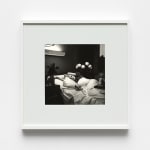Peter Hujar
Candy Darling on Her Deathbed, 1973
pigmented ink print
impressão com tinta pigmentada
impressão com tinta pigmentada
37.5 x 37.5 cm (imagem)
14 3/4 x 14 3/4 in (image)
50.8 x 40.6 cm (papel)
20 x 16 in (paper)
14 3/4 x 14 3/4 in (image)
50.8 x 40.6 cm (papel)
20 x 16 in (paper)
Candy Darling on her Deathbed 1973 is one of a group of black and white portrait photographs in Tate’s collection by the American photographer Peter Hujar (see Tate P82408–P82412). Candy...
Candy Darling on her Deathbed 1973 is one of a group of black and white portrait photographs in Tate’s collection by the American photographer Peter Hujar (see Tate P82408–P82412). Candy Darling was one of the transgender superstars made famous by American pop artist Andy Warhol (1928–1987) in New York in the early 1970s. She appeared in a number of Warhol’s films, such as Flesh 1968 and Women in Revolt 1971, and also famously inspired the singer Lou Reed’s hit Walk on the Wild Side (1972). Hujar’s portrait of Candy shows her in a hospital bed, surrounded by flowers, shortly before she died of cancer at the age of twenty-nine. A single rose lies on the bed by side and Candy adopts a vampish pose, her face heavily made up. Hujar later wrote of the photoshoot that Candy was ‘playing every death scene from every movie’ (quoted in Peter Schjeldahl, ‘The Bohemian Rhapsody of Peter Hujar’, The New Yorker, 5 February 2018, https://www.newyorker.com/magazine/2018/02/05/the-bohemian-rhapsody-of-peter-hujar, accessed 25 April 2018.)
Hujar was a familiar figure in the cultural world of downtown New York during the 1970s and 1980s and was involved with different scenes such as visual art, punk music, performance and political activism. He died in 1987 from an AIDS-related illness, like so many of his contemporaries. His intimate and informally staged portraits of renowned artists and writers, as well as of many anonymous New Yorkers, remain as a document of the circles he moved in at a critical time in the history of New York’s counterculture. Hujar also carried out a photographic study of the mummified figures in the ancient catacombs in the Sicilian capital of Palermo and a number of these were published, with a preface by the American writer Susan Sontag, alongside a selection of his New York photographs in his book Portraits in Life and Death in 1976.
This print is a posthumous estate print made by Hujar’s friend and protégé Gary Schneider in an edition of ten, of which this is number five. Hujar entrusted some of his printing to Schneider during his lifetime and approved the concept of posthumous editions as long as Schneider did the printing.
Further reading
Peter Hujar. Speed of Life, exhibition catalogue, Fundacion Mapfre, Barcelona, 27 January–30 April 2017, Fotomuseum The Hague, 1 July–15 October 2017, The Morgan Library & Museum, 26 January–20 May 2018, Berkeley Art Museum & Pacific Film Archive, California, 11 July–7 October 2018.
Peter Schjeldahl, ‘The Bohemian Rhapsody of Peter Hujar. Photographs at the Crossroads of High Art and Low Life’, The New Yorker, 5 February 2018, https://www.newyorker.com/magazine/2018/02/05/the-bohemian-rhapsody-of-peter-hujar, accessed 10 April 2018.
Edward M. Gómez, ‘Peter Hujar’s Elegy for New York City in the 1980s’, Hyperallergic, 24 February 2018, https://hyperallergic.com/428018/peter-hujar-speed-of-life-morgan-library-and-museum/, accessed 10 April 2018.
Monika Bayer-Wermuth
April 2018
Hujar was a familiar figure in the cultural world of downtown New York during the 1970s and 1980s and was involved with different scenes such as visual art, punk music, performance and political activism. He died in 1987 from an AIDS-related illness, like so many of his contemporaries. His intimate and informally staged portraits of renowned artists and writers, as well as of many anonymous New Yorkers, remain as a document of the circles he moved in at a critical time in the history of New York’s counterculture. Hujar also carried out a photographic study of the mummified figures in the ancient catacombs in the Sicilian capital of Palermo and a number of these were published, with a preface by the American writer Susan Sontag, alongside a selection of his New York photographs in his book Portraits in Life and Death in 1976.
This print is a posthumous estate print made by Hujar’s friend and protégé Gary Schneider in an edition of ten, of which this is number five. Hujar entrusted some of his printing to Schneider during his lifetime and approved the concept of posthumous editions as long as Schneider did the printing.
Further reading
Peter Hujar. Speed of Life, exhibition catalogue, Fundacion Mapfre, Barcelona, 27 January–30 April 2017, Fotomuseum The Hague, 1 July–15 October 2017, The Morgan Library & Museum, 26 January–20 May 2018, Berkeley Art Museum & Pacific Film Archive, California, 11 July–7 October 2018.
Peter Schjeldahl, ‘The Bohemian Rhapsody of Peter Hujar. Photographs at the Crossroads of High Art and Low Life’, The New Yorker, 5 February 2018, https://www.newyorker.com/magazine/2018/02/05/the-bohemian-rhapsody-of-peter-hujar, accessed 10 April 2018.
Edward M. Gómez, ‘Peter Hujar’s Elegy for New York City in the 1980s’, Hyperallergic, 24 February 2018, https://hyperallergic.com/428018/peter-hujar-speed-of-life-morgan-library-and-museum/, accessed 10 April 2018.
Monika Bayer-Wermuth
April 2018
1
of
33



